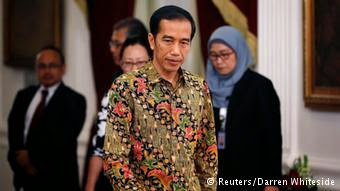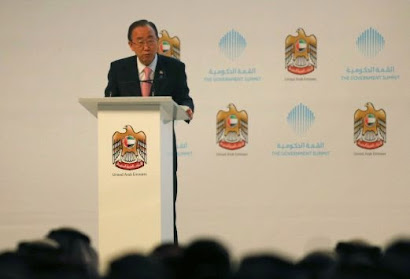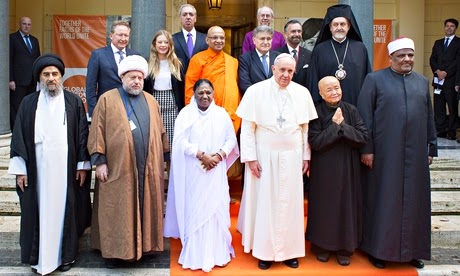Jakarta Globe, Sylviana Hamdani, October 04, 2012
 |
| Onlookers gaze at a piece at the new Erasmus Huis exhibit. (JG Photo) |
Related
articles
When you
walk through the gates of Erasmus Huis, the Dutch cultural center in South
Jakarta, it feels like you’ve suddenly been transported to Amsterdam.
A
12-meter-by-1.5-meter version of the ‘‘I Amsterdam’’ sculpture welcomes
visitors at the front of the building. The original ‘‘I Amsterdam’’ piece is a
popular attraction as well as a famous photo spot for tourists in the Dutch
capital. The Erasmus Huis miniature of the sculpture was presented recently for
the opening of the ‘‘Rijksmuseum 2.0” exhibition.
The
red-and-white piece is especially beautiful at night while highlighted by
dozens of spotlights.
The
Rijksmuseum, the Dutch national museum located in Amsterdam, is over 200 years
old, though since 1885, the museum has been housed in a grand Renaissance
building designed by award-winning Dutch architect Pierre Cuypers. After more
than 100 years in this locale, the museum was due for a makeover, so a major
renovation project in 2000 was launched by the Dutch government.
The free
Erasmus Huis exhibition, which runs until Oct. 12, showcases selections of the
museum’s extensive collection, as well as the progress of the current
renovations through pictures and videos.
Spanish
architects Antonio Cruz and Antonio Ortiz, responsible for revamping the museum,
were faced with the challenge of stripping the building of its later additions
while restoring Cuypers’ original layout.
After 12
years of work, the renovations are now in their final stages. The museum is
scheduled to open to the public on April 13, 2013.
“This
exhibition is a sneak preview of the museum from us,” Erasmus Huis director Ton
van Zeeland said at the opening of the exhibition on Sept. 24. “It [is] a
digital and three-dimensional experience [of] the new Rijksmuseum.”
The main
90-square-meter exhibition hall of Erasmus Huis has been transformed to
represent the grandeur of the Rijksmuseum, an ornate marriage of the Gothic and
Renaissance styles.
At the door
stands three life-sized pop-up panels, as well as floor-to-ceiling wallpaper
that portrays the museum’s lavish exterior as seen in the day time.
Four large
LCD screens detail the progress of the renovations and also showcase digital
animations of the work completed so far.
“They’ve
redone it completely [from the] inside out,” said Tjeerd de Zwaan, the Dutch
ambassador to Indonesia. “One of the most important things [we did] is restore
the inside to its original condition [as] it was built in 1885.”
According
to the ambassador, the interior of the museum was originally covered in murals
that were eventually whitewashed during later years to highlight the museum’s
priceless art collection.
“They’ve
now cleaned all the walls and all the ceilings and restored the murals,” said
the ambassador. “It’s a very painstaking job, but it looks breathtaking now. It
almost looks like a cathedral [on the inside].”
After the
renovations are done, the museum will contain new facilities such as souvenir
shops and a cafe.
“There will
also be paintings about Indonesia from the 17th and 18th century during the
Dutch East India Company era [featured],” the ambassador said.
Additionally,
a two-hour film that explains how workers removed, transported and stored the
museum’s precious collections during the renovation will be screened in the
Erasmus Huis exhibition hall.
Tubagus
Andre Sukmana, director of Indonesia’s National Gallery, attended the opening
of the exhibition and discovered many things from it.
“There is a
lot for us to learn from the renovation of the Rijksmuseum,” Tubagus said.
“From the film, we can learn how to renovate and rehabilitate old museum
building[s] while also taking good care of [their] collections.”
The center
of the Erasmus Huis exhibition hall features a magnificent three-dimensional
representation of the painting “The Night Watch” by Dutch maestro Rembrandt,
the museum’s most iconic holding.
The replica
of the magnificent painting fills an entire wall, while the three main
“watchmen” were taken out of the painting and made into life-sized pop-ups that
are positioned in front of the piece.
Dutch
filmmaker Jord den Hollander, another attendee at the opening night, said he
was extremely impressed by the installation.
“I was 12
years old when I went to the Rijksmuseum for the very first time,” Hollander
said. “I was very much impressed by the real Rembrandt’s ‘Night Watch.’ That
was very huge to me, and I’m very happy that this evening I can see it in [the]
Erasmus Huis in 3D.”
The
exhibition was the brainchild of Erasmus Huis in-house designer Boy Siahaan and
involved two months of development.
“This is
the next Rijksmuseum after the major renovation,” Boy said. “We really wanted
to wow the audience.”
The
designer, who has never been to the Rijksmuseum himself, conceptualized the
exhibition from extensive research and videos of the museum. He then requested
high-resolution files from the museum to create replicas of the paintings for
this exhibition.
“We also
wanted the audience not only to see, but also to interact with the pieces,” Boy
said.
Attendees
that take their pictures in front of Rembrandt’s three-dimensional painting can
send their pictures to erasmushuis@minbuza.nl. Twenty-five selected pictures
will be displayed at the exhibition each week.
“The most
attractive photo each week will [receive] a unique gift,” Boy said.
Across from
“The Night Watch” lays the ‘‘Winter Landscape” by Dutch painter Hendrick
Avercamp. A notice beside the painting encourages the audience to spot people
doing certain activities within the painting and tag them on Facebook or
Twitter.
In another
popular piece at the Huis exhibition, the Rijksmuseum’s prized 17th century
Doll’s House, was made into an interactive puzzle game. The puzzle is placed on
a table at the center of the exhibition hall, and on opening night, those who
attended lined up to try to put together the pieces.
“I truly
fell in love with ‘The Milkmaid’ [by Dutch artist Johannes Vermeer],” Boy said.
“The details are amazing. [It’s] as if they’re real.”
The
painting portrays a maid pouring milk into a Dutch oven on a table full of
different breads. The interior of the room in the painting is very plain, but
the little details are extremely intricate, especially the nails on the walls,
dull floor tiles and broken window.
At the end
of the space, a replica of the ‘‘St. Bavo Church, Haarlem,’’ a masterpiece by
Dutch painter Pieter Jansz Saenredam, is featured.
The
floor-to-ceiling painting cleverly masks a door at the end of the exhibition
hall.
“It’s the
most difficult corner for us to decorate,” Boy said. “Luckily, we’ve found this
beautiful piece in the museum’s collection that we could replicate to suitably
cover the door.”
The
painting showcases the inside of the St. Bavo Church as seen through the tall
white arches.
“With this
painting at the end of the exhibition hall, we actually want to point out to
the audience that there is a lot more to the Rijksmuseum than what we can
present here,” Boy said.
“They
should [go] and see it for themselves.”















